Table of Contents
What is Market Segmentation?
Market segmentation means how the organization divides customers into smaller group that is relatively similar and identifiable. The main purpose of marketing segmentation is to meet the needs of one or more specific segments.
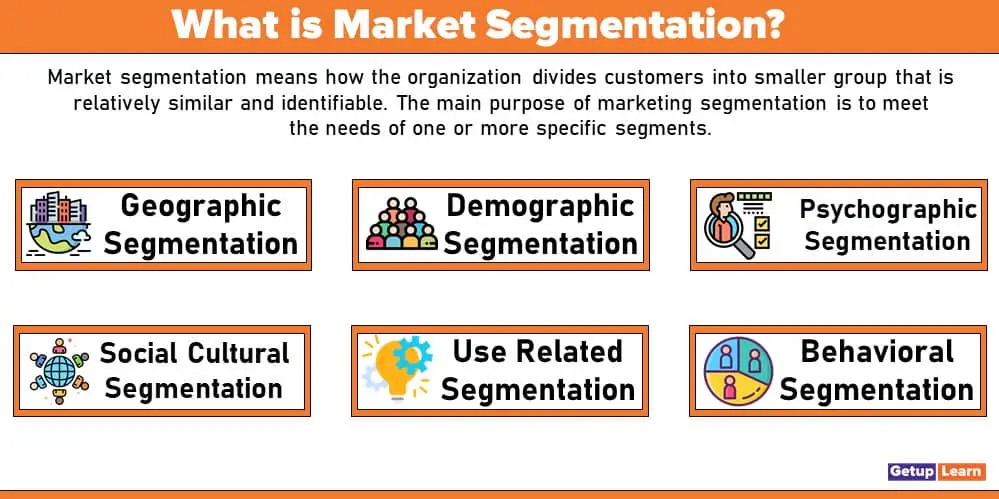
-
Identifiable: differentiating attributes of segments must be measurable so that they can be identified.
-
Accessible: the segments must be reachable through communication and distribution channels.
-
Substantial: the segments should be sufficiently large to justify the resources required to target them.
-
Unique Needs: Justifying separate offerings, segments must respond differently to different marketing mixes.
- Durable: The segments should be relatively stable to minimize the cost of frequent changes.
Meaning of Market Segmentation
Segmentation refers to ‘division’ or ‘demarcation’. A market consists of heterogeneous components or elements. These heterogeneous or dissimilar elements mean consumers differ in their taste preference, nature, attitude, income, buying habits, decision-making, etc.
These heterogeneous elements are divided into homogenous clusters on the basis of common or similar characteristics. Each homogenous segment represents common characteristics as a market segment and the process of dividing the market is known as Market Segmentation.
A market segment is the grouping of buyers according to common characteristics such as income, age, sex, qualification, geographical location, etc so that their needs are better served.
Definition of Market Segmentation
These are the following definitions of market segmentation:
[su_quote cite=”Schiffman and Kanuk”]Market segmentation can be defined as the process of dividing a market into distinct subsets of consumers with common needs or characteristics and selecting one or more segments to target with a distinct marketing mix.[/su_quote]
[su_quote cite=”S.J. Skinner”]Market segmentation is the process of dividing a total market into groups of consumers who have relatively similar product needs.[/su_quote]
[su_quote cite=”Rajan Saxena”]Market segmentation defines segmentation as the process of dividing a heterogeneous market into homogenous subunits.[/su_quote]
[su_quote cite=”Philip Kotler”]Market segmentation is the act of dividing a market into distinct groups of buyers who might merit separate products and/or marketing strategies.[/su_quote]
[su_quote cite=”R. S. Davar”]Grouping of buyers or segmenting the market is described as market segmentation.[/su_quote]
[su_quote cite=”W. J. Stanton”]Market segmentation consists of taking the total, the heterogeneous market for a product and dividing it into several sub-markets or segments each of which tends to be homogeneous in all significant aspects.[/su_quote]
[su_quote cite=”Alan. A. Robert”]Market segmentation is the strategy of dividing markets in order to conquer them.[/su_quote]
So, on the basis of the above definitions, it can be concluded that segmentation is to divide a market consisting of consumers with diverse characteristics and behaviors into homogenous segments that contain persons who will all respond similarly to a firm’s marketing effort. When this is done, the company is in a position to answer “What are our target markets.”
Basis of Market Segmentation
These are the basis of market segmentation with examples:
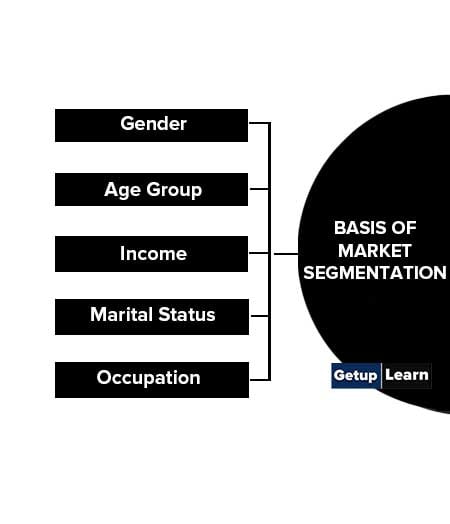
Gender
The world market is basically divided into two parts i.e. Male and Female on the basis of gender. As the preferences of both males and females are different, the marketer needs different strategies for both. For example, cosmetics, Apparel, and Jewellery Industries.
Age Group
The choice and preference change according to age. For Example Teenagers like fashionable cloth, whereas adult-like simple and sober clothes.
Income
There exist various income groups of people in society. Their choice and preference vary on the basis of the income they earn. The ones that fall under high income, prefer to purchase a branded product and live a very lavish life.
Whereas, the ones who earn mid-income may not be able to afford the branded things. Marketers have to keep both types of customers in mind while defining their strategies.
Marital Status
Bachelor has a different preference and a married couple has a different choice. For Example Travel Packages for both statuses will be different.
Occupation
According to the occupation, the preference also differs. People in Blue Collar jobs and White Collar jobs have different choices for clothes. Office goers and school children have different choices.
Types of Market Segmentation
These are the types of market segmentation explained below:
- Geographic Segmentation
- Demographic Segmentation
- Psychographic Segmentation
- Social Cultural Segmentation
- Use Related Segmentation
- Behavioral Segmentation
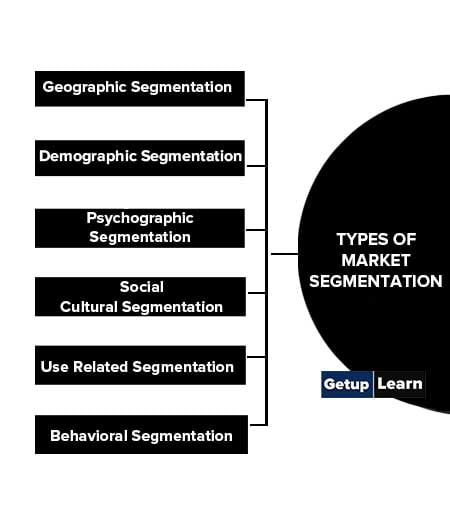
Geographic Segmentation
In geographic segmentation, the market is divided by location. The theory behind this strategy is that people who live in the same area share some similar needs and wants and that these needs and wants differ from those of people living in other areas.
For example, certain food products sell better in one region than in others. Some marketing theorists and marketing practitioners believe that worldwide satellite television transmission and global communication networks have erased all regional boundaries and therefore, that geographic segmentation should be replaced by a single global marketing strategy.
Demographic Segmentation
Demographic segmentation is the common and most effective method of segmenting the consumer market. Consumer demography includes variables such as age, family size, gender, income, occupation, education, religion, race, generation, nationality, or social class.
Psychographic Segmentation
Psychological characteristics refer to the inner or intrinsic qualities of the individual consumer. Consumer segmentation strategies are often based on specific psychological variables. For instance, consumers may be segmented in terms of their needs and motivations, personality, perceptions, learning, level of involvement, and attitudes.
Examples: Colgate Palmolive, AT & T services, Kentucky fried Chicken, and Nescafe Coffee. Marketers conduct psychographic research to capture insights and create profiles of the consumers they wish to target.
Sociology and anthropological variables- that is, socio-cultural variables- provide further bases for market segmentation. For example, consumer markets have been successfully subdivided into segments on the basis of stages in the family life cycle, social class, core cultural values, sub-cultural memberships, and cross-cultural affiliation.
An extremely popular and effective form of segmentation categorizes consumers in terms of product, service, or brand usage characteristics, such as usage rate, awareness status, and degree of brand loyalty. Rate of usage segmentation differentiates among heavy users, medium users, light users, and nonusers of a specific product, service or brand”.
Marketers of a host of other products have also found that a relatively small group of heavy users account for a disproportionately large percentage of product usage and that targeting these heavy users has become the basis of their marketing strategy.
Behavioral Segmentation
A large number of marketers are of the opinion that behavioral variables are the best starting point for constructing market segments. In behavioral segmentation, consumers can be divided into groups on the basis of their attitude, use, knowledge, expectation from the product, usage rate, usage habits, etc. Generally, the following basis is adopted to segment the markets.
-
Occasion: Regular occasion, for example having fruit juice after breakfast. Special occasions, for example, new dresses during puja and Bihu.
-
User Status: Non-user, ex-user, potential user, the regular user.
-
Usage Rate: Light user, medium user, the heavy user.
-
Loyalty Status: Soft loyal, hard loyal, shifting loyalties, switchers, etc.
- Attitude Towards: Positive, indifferent, negative, hostile, etc. products & services.
Steps in Market Segmentation
These are the steps in market segmentation:
- Select a Market
- Identify the Expectations of Target Audience
- Create Subgroups
- Review Needs of Target Audience
- Name Your Market Segment
- Marketing Strategies
- Review Behavior
- Size of Target Market
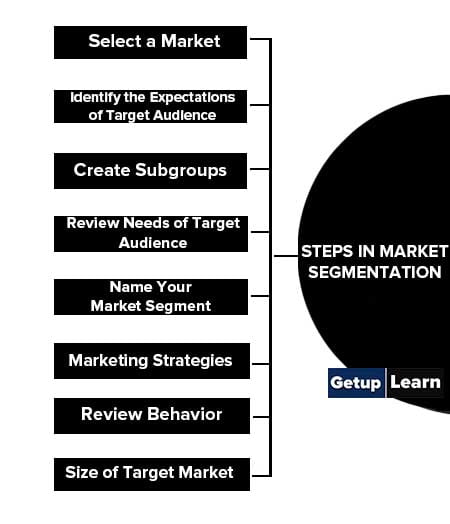
Select a Market
In this step, the Market should be identified. It may be the market in which the firm already competes, a new but related market, or a totally new one. The marketers must be very clear as to whom they should include in a segment, making sure the individuals have something in common.
Identify the Expectations of Target Audience
In this step, it is essential to find out the needs of the target audience. The marketers interact with the target audience in order to identify their needs, demands, and interests.
Create Subgroups
Once the target market is identified create a subgroup within the group. For Example In India girls between 20–25 years focus more on fairness creams and lotions, whereas girls between 25 to 35 years are keen to reduce the signs of aging. Marketers will have to have cosmetics for both categories.
Review Needs of Target Audience
It is essential for the marketer to review the needs and preferences of individuals in each segment and sub-segment. The consumers of a particular segment must respond to similar fluctuations in the market and similar marketing strategies.
Name Your Market Segment
In this step, marketers should give proper names to each segment, which helps to implement the strategy easily.
Marketing Strategies
Relevant strategies should be devised in order to promote brands amongst each segment. The same Strategies cannot be used for all the segments. Marketers should make sure that there is a connection between the product and the audience.
Review Behavior
Marketers should keep on reviewing the behavior of the target audience as the needs keep on changing and individuals would not have the same requirements throughout the year.
Size of Target Market
It is essential to know the target market size. Collect necessary data for the same. It helps in sales planning and forecasting.
Levels of Market Segmentation
The number of possible segments that will result from a segmentation analysis can be as few as one or as many as the total number of consumers that are in the total market.
The marketer’s choice of segments should reflect actual similarities in consumer background characteristics and behaviors that will result from similar purchase decisions. Typically, various kinds of markets can result from a segmentation analysis.
Following are the levels of market segmentation explained below:
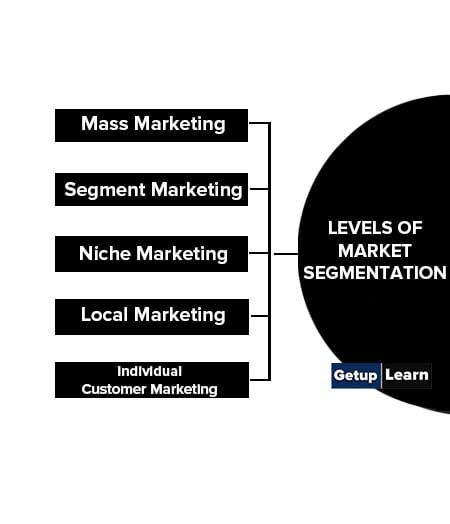
Mass Marketing
In mass marketing consumers are indistinguishable and all are in one segment. Here the seller engages in the mass production, mass distribution, and mass promotion of one product for all buyers.
The essence of this strategy was summed up by the entrepreneur Henry Ford, who offered the Model T automobile to the public “in any color they wanted, as long as it was black”. Mass marketing would be a logical strategy if all consumers were alike regarding their needs, wants, and demands with the same background, education, and experience. Its primary advantage is that it costs less.
But in the diversified market, this strategy does not seem logical and ultimately marketers end up with the strategy of ‘segmented market’.
Segment Marketing
A segmented market is one in which meaningful differences among consumers result in a modest number of segments. Here the segment consists of a group of customers who share a similar set of wants.
The strategy of segmentation allows producers to avoid head-on competition in the market by differentiating their offerings, not only on the basis of price, but also through styling, packaging, promotional appeal, method of distribution, and superior service.
Niche Marketing
Nowadays marketers are increasingly using highly focused marketing programs to target small consumer niches with products and services that fit their interests and lifestyles. Niche marketing is sometimes also called micro-marketing.
Marketers usually identify niches by dividing a segment into sub-segments. The customers in the niche have a different set of needs and they are also ready to pay a premium to the firm that best satisfies their needs.
The niche is not likely to attract competition from other marketers. For example, Ferrari gets a high price for its cars because loyal buyers feel no other automobile comes close to offering the product, or service membership benefit bundle that Ferrari does.
Local Marketing
When marketing programs are designed to cater to the needs and wants of local customer groups (trading areas, neighborhoods, individual stores). For example, Punjab National Bank and State Bank of India provide different mixes of banking services in their different branches, depending on neighborhood demographics.
You can always find a vegetable shop near to your locality and in the same manner a drug store or a retail store so that the needs and wants of local customer groups can be fulfilled.
Individual Customer Marketing
When a marketer detects as many segments as there are consumers, so that each segment is composed of only one consumer, it has been identified as individual marketing or customized marketing. This results when the marketer believes that no two consumers will respond similarly to its marketing efforts.
As a result, the marketer is forced to produce a customized product specifically designed and positioned for each consumer to whom it wants to market. Health and exercise marketers provide examples of customized marketing.
They are the personal trainers who develop a customized exercise program for their clients and exercise with them on an individual basis. Today the information revolution is enabling a growing number of companies to mass-customize their offerings.
Mass-customisation is the ability of a company to prepare on a mass basis individually designed products, services, programs, and communication to meet each customer’s requirements. It is a strategy that mobilizes the combined power of mass production technologies and computers to make varied, customized products for individual customers.
Market Targeting
Market targeting is a process of identifying the target market from the total market. The target market contains a group/groups of customers to whom the firms want to satisfy or as per their desire, the companies manufacture the product or services, set prices, conduct promotional activities and the distribution network is made.
- Single Segment Concentration
- Selective Specialization
- Market Specialization
- Product Specialization
- Full Market Coverage
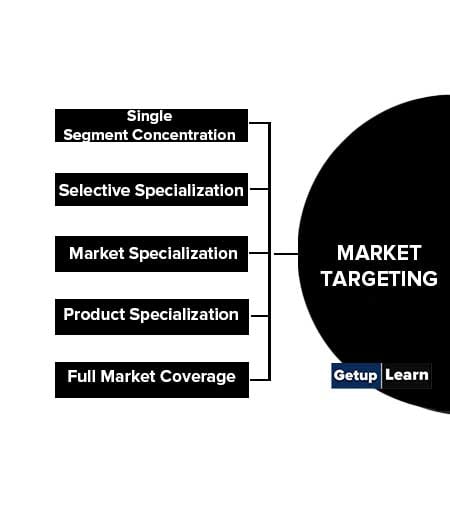
Single Segment Concentration
Here firms operate in a single market segment with a single product. For instance, the P2 product is launched in market segment M1. Firms are assumed to have a thorough knowledge of the selected segment of the market.
Since a firm has only one product, it can enjoy specialization and operating economies i.e. production, distribution, and promotion. A high level of risk is involved in segment selection. Faulty selection can result in product failure.
For Example, Mahindra and Mahindra company through their tractors aims only to target the agricultural market.
Selective Specialization
It is a multi-segment strategy where firms operate in different segments of the market with different products. For instance, the P2 product is launched in the M1 segment of the market, the P3 product for the M2 segment of the market, and the P3 product for the M3 segment of the market.
Here each segment of the market tends to be different, but there is sufficient scope for making money is these markets. The degree of risk involved becomes less as firms focus on more than one market segment.
For Example, Zee (Tv Channel) targets three different segments of the market. Zee TV is meant for adults and house wife’s, Zee Jagran is meant for the older segment of society and Zee trend is meant for fashion-loving people of the society.
Market Specialization
Here firms operate in different segments of the market with a single product. For instance, the P2 product is meant for all three segments of the market M1, M2, and M3. Firms build a strong reputation by serving different customer groups in different segments of the market.
For Example, Microscope manufacturers target colleges, schools, and university laboratories to sell their products.
Product Specialization
Here firms operate in a single market with a variety of products. The aim is to fulfill many needs of a particular customer group. A strong reputation is built within a specific customer group with different products. For instance, P1, P2, and P3 products are meant for single market M1.
For Example, Laboratory manufacturers produce Bunsen burners, conical flasks, and microscopes for university laboratories.
Full Market Coverage
Here firms operate in all segments of the market with varieties of products. Full market coverage provides wider scope since firms can serve all customer groups with different requirements. Large firms attempt to cover all the segments of the market through two different strategies:
- Undifferentiated Marketing
- Differentiated Marketing
What is the basis of market segmentation?
The basis of market segmentation is:
1. Gender
2. Age Group
3. Income
4. Marital Status
5. Occupation.
What are the types of market segmentation?
Following are the types of market segmentation:
1. Geographic Segmentation
2. Demographic Segmentation
3. Psychographic Segmentation
4. Social Cultural Segmentation
5. Use Related Segmentation
6. Behavioral Segmentation.
What are the steps in market segmentation?
Steps in Market Segmentation are:
1. Select a Market
2. Identify the Expectations of Target Audience
3. Create Subgroups
4. Review Needs of Target Audience
5. Name Your Market Segment
6. Marketing Strategies
7. Review Behavior
8. Size of Target Market.
What are the levels of market segmentation?
These are the levels of market segmentation:
1. Mass Marketing
2. Segment Marketing
3. Niche Marketing
4. Local Marketing
5. Individual Customer Marketing.
What are the market targeting strategies?
Market targeting strategies are given below:
1. Single Segment Concentration
2. Selective Specialization
3. Market Specialization
4. Product Specialization
5. Full Market Coverage.







